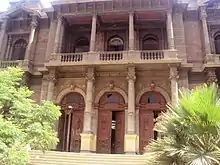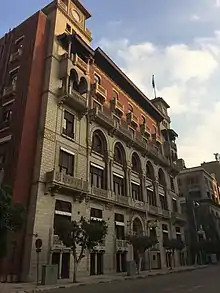
Antonio Lasciac (Italian) or Anton Laščak (Slovene) (21 September 1856 – 26 December 1946) was an architect, engineer, poet and musician of Slovene descent, who designed the Khedive's Palace in Istanbul and the Tahra Palace in Cairo.[1][2][3]
Life



Lasciac was born to Peter Laščak and Jožefa (née Trampuš) in the Italian Gorizia suburb of San Rocco (Slovene: Podturn) in 1856. At the time this was part of the Austrian Empire, today it is in Italy. He was the first of ten children. Three of his siblings died in childhood. He migrated to Gorizia and opened a business with Mihael Trampuš, another Slovene. He fell in love with Trampuš's daughter and took over his crafts workshop after the marriage. Her official Italian name is written as Gioseffa. Her father Mihael was born in Gorizia, to farmers from the surrounding Karst Plateau.
After finishing primary and secondary school in Gorizia, Lasciac studied at the Vienna Polytechnic Institute.[4] While still a student,[4] Lasciac married Maria Plesnizer (also Marija Alojzija Plesničar[5]) from a Slovene family. Maria bore three children[6] with unusual and fully Italian names: Plautilla Angelina Francesca, Fabrizio Antonio Giuseppe and Romeo Italico Alessandro (died 1926[7]).[5]
He first traveled to Egypt to assist in rebuilding Alexandria after the destruction by the British Bombardment of Alexandria in July 1882.[8] Under the Khedive Abbas II of Egypt, he got a job and title as an Egyptian court architect in 1907.[8] Later he lost this job.[9] During World War I, as national of Austria-Hungary and thus of the enemy he had to leave Egypt.[9] After the war, he returned to Egypt and used to spend the summers in Gorizia and the winters in Egypt.[9] After moving to Cairo on 5 October 1946 he died there on 26 December 1946. He was buried at the Latin Cemetery in Cairo.[10]
Lasciac designed buildings in Gorizia and many Eastern capitals and cities, especially Egypt.[3] The Khedive's Palace in Istanbul and the Tahra Palace in Cairo (1907) are among his most notable works. Of his drawings about a hundred have survived. As of 2015, they were in the private archive of Mercedes Volait in Paris.[11]
Works (incomplete)

- apartment buildings for the Societé des Immeubles d'Egypte, 1883-1886, rue Cherif, Alexandria[12]
- Menasce Okelle (or Galleria Menasce), 1883–1887, Alexandria[13]
- Ramleh Railway Station, 1887, Alexandria (today replaced)[12][14]
- Headquarters of the Jewish Community of Alexandria, 1887, Alexandria[12]
- Prince Said Halim Pasha Palace, 1896–1899, Maarouf, Downtown, Cairo[15][16] (later Nasriya school)
- Suarès Palace (later Risotto Club), 1897, Cairo[15][17]
- Villa Mazloum Pasha, 1898–1899, Alexandria[18]
- Palace of Prince Kamal Al-Din Hussein And Princess Niemat-Allah, 1906, Cairo[18][19]
- Aisha Fahmy Palace, 1907, Zamalek, Cairo
- Tahra Palace, 1907, Cairo
- Khedive's Palace, 1907, Istanbul
- Villa Lasciac, 1909, Gorizia[13][20]
- Abdeen Palace, extension, Cairo[21]
- Assicurazioni Generali di Trieste SpA building, 1911, Cairo[18][22][23]
- St. Peter and St. Paul's Church, 1911, Cairo
- Villa of Princess Fatma Al-Zahra, 1919, Alexandria[18] (today Royal Jewelry Museum)
- Headquarters of Banque Misr, 1927, Cairo[24]
Honors
Asteroid 292459 Antoniolasciac, discovered by astronomers at the Italian Farra d'Isonzo Observatory in 2006, was named in his memory.[2] The official naming citation was published by the Minor Planet Center on 14 November 2016 (M.P.C. 102259).[25]
References
- ↑ Kuzmin 2015.
- 1 2 "292459 Antoniolasciac (2006 SO366)". Minor Planet Center. Retrieved 12 September 2019.
- 1 2 "From Gorizia To The Ottoman Empire – Architect Antonio Lasciac". Italy. Archived from the original on 22 July 2011. Retrieved 10 March 2010.
- 1 2 Kuzmin 2015, p. 198.
- 1 2 "Življenjepis kraljevega arhitekta Anton Laščak beg (Gorica 1856 – Kairo 1946)". tinomamic (in Slovenian). Retrieved 10 January 2022.
- ↑ Kuzmin 2020, p. 113, and footnote 3 on p. 117.
- ↑ Kuzmin 2020, p. 117, footnote 18.
- 1 2 Kuzmin 2020, p. 113.
- 1 2 3 Kuzmin 2020, p. 116.
- ↑ Kuzmin 2020, p. 116. A photo of his grave can be found in idem, p. 115.
- ↑ Kuzmin 2015, p. 200.
- 1 2 3 Kuzmin 2020, p. 114.
- 1 2 O'Kane 2020.
- ↑ For a picture of the old building see Kuzmin 2015, p. 206, fig. 3
- 1 2 Al-Naggar 2021, p. 211.
- ↑ Scientific Office of the Italian Embassy in Egypt, p. 16.
- ↑ Scientific Office of the Italian Embassy in Egypt, p. 20.
- 1 2 3 4 Al-Naggar 2021, p. 212.
- ↑ Scientific Office of the Italian Embassy in Egypt, p. 12.
- ↑ Barillari 1998.
- ↑ Scientific Office of the Italian Embassy in Egypt, p. 26.
- ↑ Scientific Office of the Italian Embassy in Egypt, p. 17.
- ↑ Barillari 2001.
- ↑ Scientific Office of the Italian Embassy in Egypt, p. 21.
- ↑ "MPC/MPO/MPS Archive". Minor Planet Center. Retrieved 12 September 2019.
Sources cited
- Al-Naggar, Abdallah Abdel-Ati (4 July 2021). "Antonio Lasciac and his architectural works in Arabic eyes". Journal of Central and Eastern European African Studies. 1 (1–2): 209–220. ISSN 2786-1902. Wikidata Q110495319.
- Barillari, Diana (1998). "La Villa "egiziana" di Antonio Lasciac sul Rafut: revival islamico nella Mitteleuropa". Borc San Roc (in Italian). 10: 43–57. Wikidata Q110496876.
- Barillari, Diana (January 2001). Les bâtiments de la compagnie des Assicurazioni Generali au Caire. Etudes Urbaines (in French) (published 2001). pp. 35–48. ISBN 978-2-7247-0290-3. ISSN 1110-2497. Wikidata Q110496330.
{{cite book}}:|journal=ignored (help) - Khalil, Mohamed Ali Mohamed. The Italian Architecture in Alexandria Egypt (Thesis submitted to University Kore of Enna to obtain Second level master's degree in architecture restoration A.A. 2008–2009)
- Kuzmin, Diego (2015). "From Middle Europe to Egypt: Antonio Lasciac Architect (1856–1946)" (PDF). New Ideas of New Century. 1: 198–208. Wikidata Q110497899. Archived from the original (PDF) on 20 December 2016. Retrieved 18 December 2016.
- Kuzmin, Diego (2020). "Biographical notes of Antonio Lasciac". Antonio Lasciac. Un architetto tra Italia, Egitto e Slovenia. Storia, Disegno, Tecnica. Atti della Conferenza Internazionale Gorizia 10–11 dicembre 2014 (in Italian and English): 113–117. Wikidata Q110496907.
- O'Kane, Bernard (20 October 2020). "The Architect Antonio Lasciac (1856–1946) in the Context of Mamluk Revivalisms". Annales islamologiques (54): 299–332. doi:10.4000/ANISL.8664. ISSN 2429-2850. Wikidata Q110495972.
- Scientific Office of the Italian Embassy in Egypt, Scientific Office of the Italian Embassy in Egypt (ed.), Cairo: An Italian Architectural Itinerary (PDF) (in Italian, Arabic, and English), Wikidata Q110495851
Further reading
- Awad, Mohamed Fouad (2008). Italy in Alexandria: Influences on the Built Environment. Alexandria: Alexandria Preservation Trust. ISBN 978-977-17-6491-5. OCLC 718194941. Wikidata Q110495697.
- Volait, Mercedes (1987). "La communauté italienne et ses édiles". Revue de l'Occident musulman et de la Mediterranee (in French). 46 (1): 137–156. doi:10.3406/REMMM.1987.2196. ISSN 0035-1474. Wikidata Q110495901.